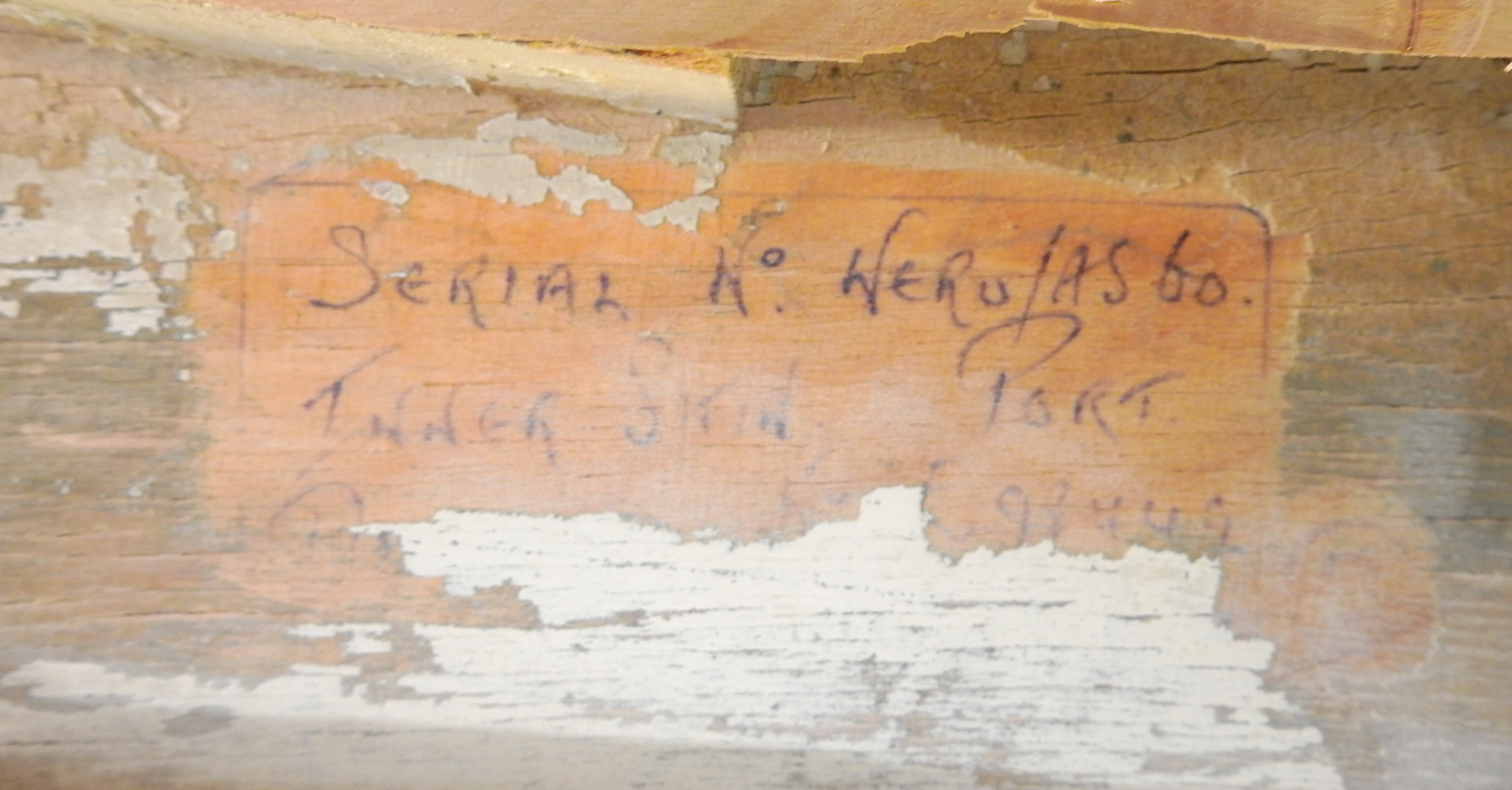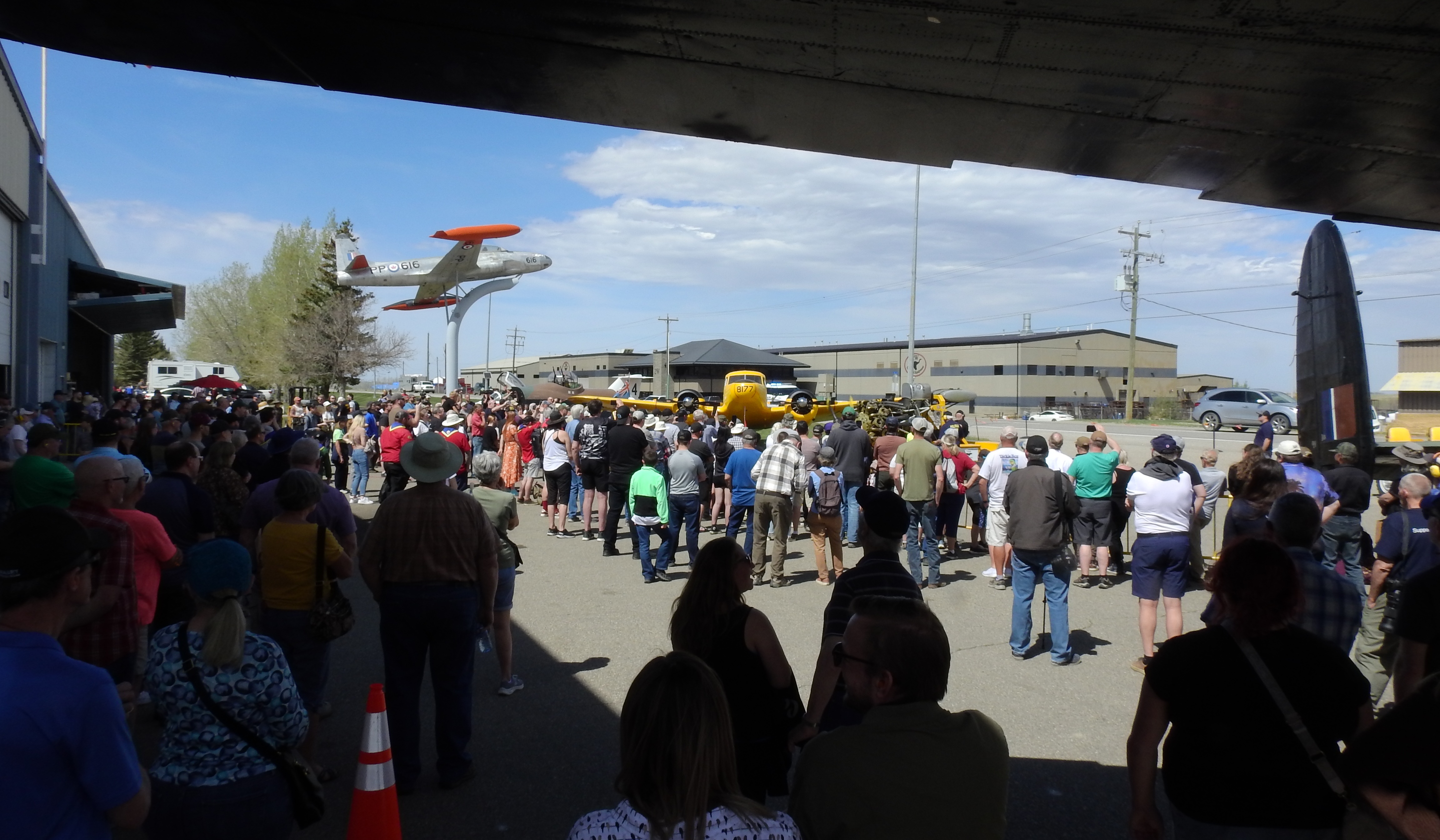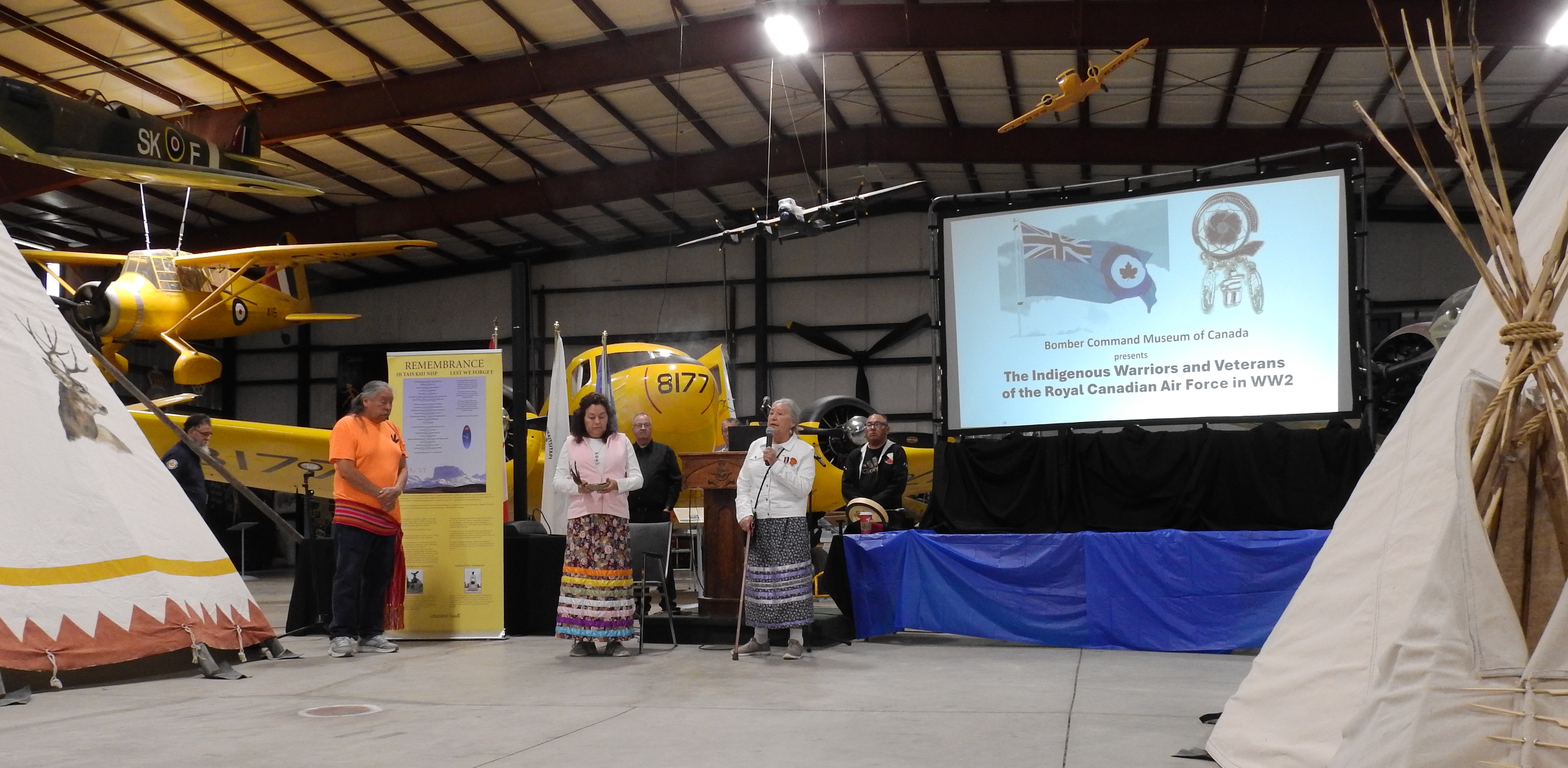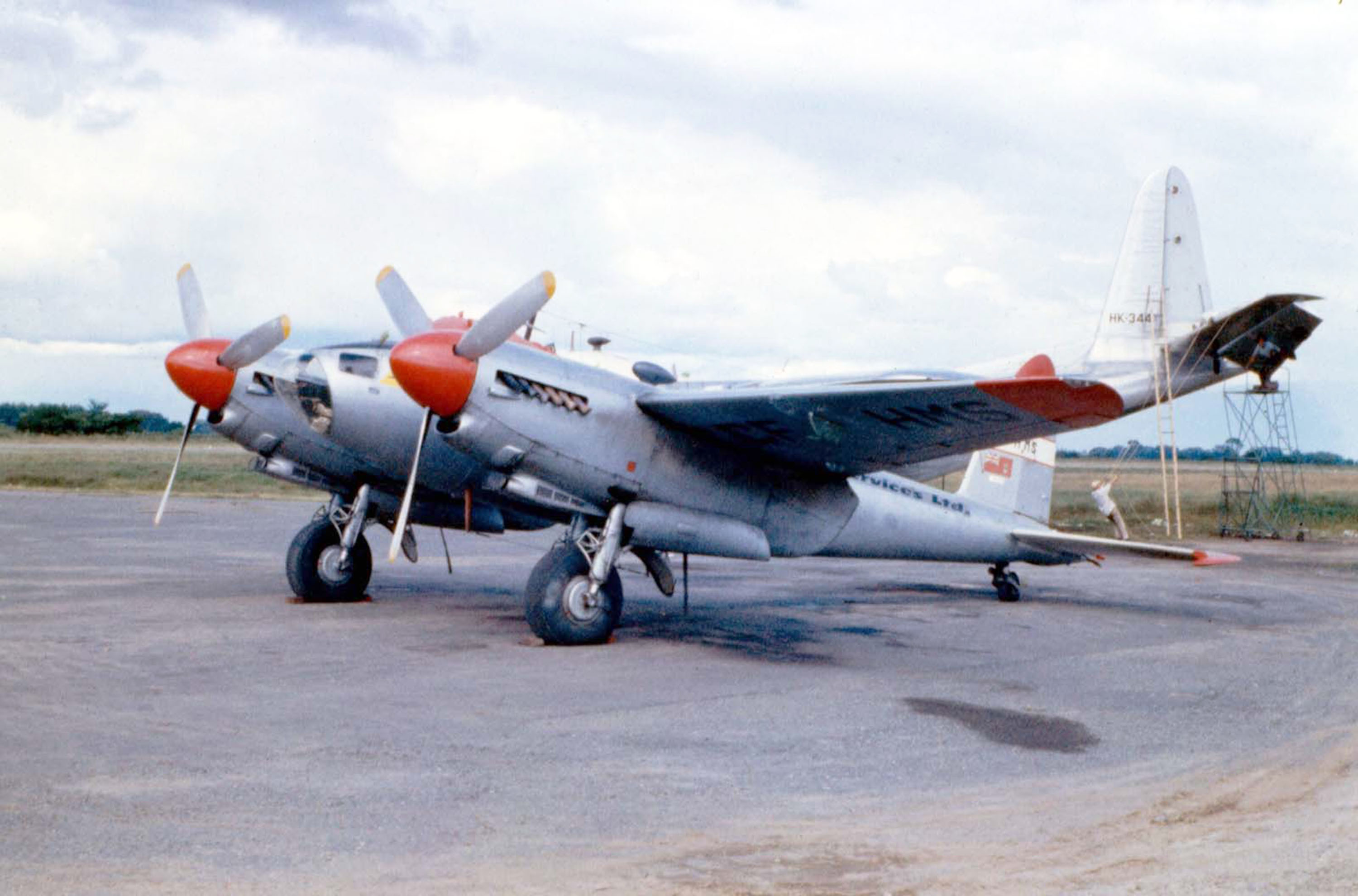
Click on any image for a slideshow!

Mosquito Clan Report for Q2, 2025
Welcome to the sweaty season of the year. Grab a cool one, sit back and read on to see what's happening with your favourite Hurricane and Mosquito.
Hurricane
On April 8, we accomplished a third start on the Hurricane's Merlin engine. Thanks to Dick S. and Davy D. we now have a detailed checklist for an engine start. Jack M. had the first start last December, Dick had the second in January and this time it was Davy's turn, as we want to allow those with the most Merlin grit under their fingernails, an opportunity to fire up this beast.
As with the two previous starts, fuel and oil lines on the test stand shook loose and we shut down the first start after a minute. Having learned from previous attempts, we knew not to prime the engine on the second start and it fired up immediately. But the god of old engines has a sense of humour and once it got up to operating temperature, the coolant line to the overflow tank blew again, releasing all the water from the system in less than a second, making for drama once more. We also saw that the large diameter coolant line from the radiator was collapsing from lack of flow. And once more we learned that our problems with the tachometer had yet to be solved, despite having a new line built by a local speed shop.

Long time volunteer and a man with a lot of Merlin grit under his fingernails, Davy D. at the controls of the Hurricane’s Packard Merlin 29 on April 8.

That now familiar scene of the hose to the coolant overflow tank having popped its clamp as soon as the engine reached operating temperature.
On the good news side of the ledger, the engine starts easily and runs well. As one of our crew observed, it's the test stand that is at the root of most of the issues, not the engine itself. Jack removed the tach and took it to Aerocorp, where Tony Chung informed us that a bevel gear was shot. Friend and supporter Darrell Brown in Ontario was able to ship out a spare tach for us to gut for a new gear. Thank you Darrell! While it is being overhauled, Jack sourced a newer model tach and remote generator. He also ordered metal pipes for the coolant system to deal with the collapsing rubber hoses as we need to get some additional run in time on the engine before we reinstall it in the Hurricane airframe. Our thanks again to Dr. Brian Taylor, 'Mr. Lanc' with the Bomber Command Museum, for coming up to assist with the engine start and run. Progress this quarter has been hampered by job demands for Jack, which have kept him out of the country for weeks at a time.
Mosquito
In the business of restoring old airplanes, it sure helps to have friends and supportive relationships, and we have those in abundance. We mentioned in the previous report that we had a number of swap deals going with the KF Aero Centre for Excellence in Kelowna, BC. Lacking our own, we asked them about getting some photos and dimensions for an air dryer that sits forward of the instrument panel, as we figure to have to make our own. Maintenance boss at KF, D'Arcy Barker did us one better by removing his from their Mosquito and sending it to us! Not only did it arrive by FedEx, but packed in the same crate were all the bits and pieces we had loaned to them over the past couple of years. Woo and hoo.

Goodies from D’Arcy Barker at KC Aero Centre for Excellence. Borrowed air dryer at right, with our tail wheel retract jack in the box with some of our aileron hinge and pushrod bits.
A large helping of thanks also goes out to Richard Fox, project head of the Mosquito restoration at Windsor, ON's, Canadian Aviation Museum. Again, we have maintained excellent relations with the group, loaning them an aileron for duplication, and last year shipping out a full undercarriage nacelle. Early this year, Windsor borrowed a large fuel gallery (or manifold depending on which side of 'The Pond' you are on) in order to be able to carve one for themselves. Ours arrived back in late June.

Rear fuselage and camera bay specialist, as well as Mosquito Society board member, Don H., re-installs the fuel gallery (big gray thing), just returned to us by the Windsor Mosquito group.
While the Windsor Mosquito folks don't have much in the way of parts to trade back in exchange for what we have loaned them, what they do have is an excellent machine shop, skilled metal bashers, and the mighty resources of Canada's industrial heartland close at hand. With those, they manufactured for us a sprung strut for rudder control. It was a very complicated build, and to their great credit it was a perfect fit and it works like a charm. We'll be tapping them for some more, 'please make' bits and bobs.

Jack McW. and Andy W. admire the handiwork of our friends in the Windsor Mosquito Group who made a complex rudder spring strut as partial payment for the goods we have loaned them over the past few years.
Still more in the 'swaps for mutual benefit' department, our board member and cockpit specialist, Andy W. has opened up a very active and mutually beneficial channel with Retrotec: The Specialist Historic Aircraft Engineering Company, in the UK. Retrotec are the primary contractors to The People's Mosquito organization which is the not for profit group which is organizing and funding a scratch built flying Mosquito for Britain. Their project got a huge boost when they located a bin of over 22,500 microfilm copies of original de Havilland drawings for the Mosquito, some twelve years ago. Sadly they have been barred by Airbus from sharing the drawings. That aside, we have been able to complete one deal that gained us some spring supports for the blind flying panel and a three-position switch for the nav lights in exchange for a set of undercarriage legs that we had spare, courtesy of Bob Jens, who owned negotiations for a number of additional trades with Retrotec. (Complicated, isn't it?).
For years we have kept a photo of a Spartan Air Services camera operator taped to the rear fuselage, just by the hatch, where the operator would enter the airplane. Last year a visitor spotted it and exclaimed 'That's my dad!' The visitor was John Tessier and his father is Roger Tessier, who we were delighted to learn is still with us and living in Edmonton.

Former Spartan Air Services camera operator, Roger Tessier, standing in exactly the same spot as he was back in 1958 when he was photographed holding a film magazine, about to enter the rear fuselage of the Mosquito. We had Roger autograph this rather poignant photo for us.
In late June father and son Tessier made a day trip to come visit us. Rear fuselage and camera specialist Don H. had a laundry list of questions for Roger to add details for restoring the camera operator's position. Beyond that, we were thrilled to listen to Roger's stories of the 'good old days', and to show him our work on his old mount. Roger was just eighteen years old when he joined Spartan. He worked for them for three years, which included a stint in Colombia when Spartan had a contract to photo-map the country in 1958. This was of special interest to our undercarriage specialist Jaimie G. who hails from Colombia. My favourite moment of the day was when Roger started to talk about his time in Colombia and he turned to his son and told him to take a walk so he could tell some stories that were not suitable for a son's ears. It was a very cool day for all parties and we extend a huge thanks to Roger and John Tessier for making the effort and supporting our project in this invaluable fashion.

A lovely moment when Colombian native, and our undercarriage specialist, Jaimie G. asked Roger Tessier about his time in Colombia when Spartan was there to photo map the country in 1958.
Now, on to some restoration talk...
Jack McWilliam
We are making good progress on quite a number of fronts as we have crews working on the fuselage interior, undercarriage, upper wing skins, trailing edge and cockpit. The wing skin replacement project is moving along well with Gary T. and gang. Paint scraping is a little tougher than usual but new volunteer Ashtyn R. and old hand Alan W. are chipping away at it. Gary has but one last wing skin to remove and replace and that major task will be complete.
While chipping away at 80 year old paint between the wing stringers near the rear spar, Ashtyn discovered a hand pencilled note. We are careful to photograph all such items and if they appear significant, we will varnish rather than paint over them as we did on the fuel tank panels on the underside of the wing. Speaking of such panels, thanks to many hands making light work, they are all scraped clean and repainted, having been returned to storage until it comes time for new fabric and installation.

New member and volunteer Ashtyn R., while scraping paint from between inner and outer wing skins, came across this long covered, handwritten note. We will delicately remove the rest of the paint and then varnish over the text to preserve it.
Gary has been sidetracked from his wing re-skinning work by the crew working with the attach brackets, as they needed him to install some walnut mounting plates on the trailing edge spar. Once these parts are installed Jerry M. and Joe M. will commence installation of the mechanical components for the flap actuators and some undercarriage pick up points. We have more of the wing and undercarriage attach parts removed from the underside of the wing that have been cleaned and gone for powder coating. We've asked Richard to play messenger boy and deliver a handful of rods to Don B. in Calgary for duplication as ours are badly corroded.

The focus of Jerry Ms. efforts since returning from his winter getaway has been to reassemble these wing and undercarriage mounts. We powder coated the fittings and replaced most of the hardware as it was badly corroded having sat inside the wood, where it was subject to the moisture therein.
Michael H. just finished removing some hard to see and extract bushings from the underside of the wing, which have now gone to Cam B. for painting. They need just a light coat and then we can reinstall them and then prime and paint more ribs and fuel tank bays.
This is a major milestone in the wing restoration because a lot of other parts will fall in around these components being installed. Some of Jerry M's work is on hold awaiting the delivery of a load of new hardware coming in from Aircraft Spruce which is due sometime this week. We will again utilize Richard's skills and talents as a courier to relay the hardware to the museum, as I am on the road again. To fill his spare time Jerry, assisted by Michael, has been working to disassembling the flap actuators. No easy task, based on the condition we have seen so far. I think we will have to build new rams as the internal corrosion on these units is deep.
If we require new rams, we may seek the machining skills of our friends in Windsor. They have done some brilliant work for us lately, including a rudder spring strut that Cam B. is just painting prior to it being installed.
Personally, I look forward to helping out the Mosquito clan in Windsor, as they, along with us, are building a community rather than an island.
Andy continues with his work in the cockpit area. We are working to sort out an issue of accessing 1/16" rivets for installing data plates in the cockpit. This style and size rivet is no longer used in aviation. The last batch I ordered for my day job was over a decade ago and I would prefer not to have to order their minimum of 500 for the sake of a few dozen that we need. We may be able to use a small batch of non-aviation grade industrial aluminum rivets to complete the task.
After more than two years worth of Saturdays, we had thought that Davy D. had finally completed the restoration of the engine firewalls, but more little things keep finding their way to us, such as brackets that went out for welding and cross members that went astray and resurfaced, needing to be attached to the wing side of the firewall.
As well as the larger projects, there are lots of individual triumphs such as Colette P. getting trailing edge parts cleaned, or Zack M. polishing the static ports and discovering original markings under all the old grunge. Alan W. has done well to reinstall long runs of copper grounding straps in the outboard fuel tank bay. This involves finding the original nail holes under the new paint, and cleaning them out before tacking down the copper with original quarter inch brads.

Alan W. enjoys a break from paint scraping to attend to the installation of copper bonding straps in the fuel bay. Alan has to locate all the original nail holes from under the paint before he can tack the strips onto the wing ribs.
Long time volunteer Nigel C. trekked back from his new home in Malaysia for a couple of weeks to work on the project, only to get assigned to 'you guessed it', scraping paint. Nigel has the advantage of height and long limbs when it comes to cleaning areas that others can't reach. Good to see you back Nigel.
Zack and I recovered some of Don's camera brackets from our storage trailer. Said trailers are still an ankle breaking obstacle course, but as we move more and more parts from storage to airframe, they get easier to navigate.
Cam B continues to put his modelling/airbrush skills to work in doing his best to keep up with everyone's requests for parts painting. In addition to being our rear fuselage and camera position man, Don H. runs around on weekdays getting parts to and from our powder coating vendor.
With Jaimie G. having completed the restoration of the first main undercarriage unit, we transferred it into the jig we had built so that we can continue with mounting the wheel and hydraulics. In the process, we discovered that some of the bolt holes in the piston cap were stripped out, so we decided to pull one from a spare gear leg to replace the stripped cap.

The restored main undercarriage assembly gets fork lifted into the jig we built in order to add the hydraulics and main wheel. A milestone moment.

Alan W., Joe M. and Dick S. take turns whacking the lower end of a spare undercarriage leg in order to get to the piston cap.
With his firewalls now finished/not finished, we have assigned Davy D. the task of replacing the copper grounding strips on the trailing edge of the horizontal stabilizer. His efforts are aided by Colette's work in cleaning every last millimeter of copper strip and Richard's diligence in photo mapping the horizontal stabilizer prior to our pulling it apart. Dick S. has been kept busy removing dents and straightening crushed surfaces in our fuel vent system, as well as doing some riveting on mounting strips and tending to the needs of our Hurricane's Merlin on weekdays.
With a bit of luck and lots of Mouse Milk, we should have our wing skin replacement complete, the wing and undercarriage attach points installed, and our flap actuators apart over the next quarter. Fingers ever crossed...
Events and Miscellaneous
We started this section of the previous quarterly report writing about the casino we held in March. At the end of May the funds came through, with even more than we had anticipated. The obsessive-compulsive part of me really wants to throw in $5 to round it up, as the total earned for the two day casino was $82,995. Again, big thanks to board member and casino organizer Michael H., as well as all the volunteers who put in some long and late shifts. Your time pays well: Thank you!
In addition to swapping parts and making deals with other organizations, we are pleased to share our knowledge and expertise as well. In early May, the KF Aero Centre for Excellence put on an event to commemorate and honour the 80th anniversary of VE Day. The Centre holds a sister ship to our Mosquito, another former Spartan Air Services machine that is the only airworthy, original de Havilland built Mosquito in the world.

The audience at KF Aero's Centre for Excellence at their VE Day Anniversary event. Former Spartan Air Services Mosquito CF-HML made a great backdrop for the event.
It is painted and finished to represent the famous F for Freddie Mosquito which finished the war with a record 213 combat operations. We were invited to give our presentation about the original F for Freddie, which sadly was lost in Calgary two days after VE Day, on May 10, 1945. KF's event was 'pay to play', and was promoted by some coverage from CBC Radio. The event was well attended with 195 in the audience. A video of the talk is up on YouTube at: 'F' For Freddie Talk by Richard de Boer at KF Aero
In late June we were invited by our friends in Penhold, AB at the Harvard Historical Aviation Society to put on an evening long workshop to share some of the secrets of our success, in organizational strategies, community support and fundraising. It was well attended by their board members and by key volunteers. Let's hope it helps their cause.
In early April we were contacted by Henry van Oene, who is with a historical recovery group in the Netherlands that had dug on a wartime crash site and wanted to confirm that the parts they had salvaged were from a Mosquito. Many of the parts were unrecognizable after being underground for 80 years, but one was quite familiar as the ring which holds a fuel tank cap. With help from Jack M. and an afternoon's worth of cleaning and scraping by Colette P., we were able to get part numbers and dimensions from one of our fuel tank caps for comparison.
Above, the fuel tank ring from a crash site in the Netherlands. Below, a fuel tank cap and ring from our Mosquito.
As these things often do, this simple request for assistance broadened into a lengthy exchange of information and back stories about VE Day, aircraft recoveries and honouring lost airmen. This group in the Netherlands has put together hundreds of pages of documentation about the crash and the crew who were lost on December 2, 1944. And as so often happens in these cases, serendipity steps in as this aircraft was with 23 Squadron of the RAF; the same squadron in which a great friend and supporter of ours, George Stewart, flew during the war.
Following up on another note from our last quarterly report, video producer Ken Cook completed his film about the volunteers with our organization. Ken's focus was not so much on the airplane as it was on the people within our group: What drew them in, what keeps them here and what connects them to the airplane. We are very pleased with the result as it is personal, touching, and quite validating. I had long assumed that we were bound by a common interest in restoring a cool old airplane. Turns out there is much more to it than that. Thank you Ken for the work that spanned many months and which has provided us with some valuable and intimate insights into the people who have devoted so much to this project. You can catch the video on YouTube at: Ken Cook - 'Save a Plane, Build a Community May 15 2025 1'
As usual, the second quarter of the year marks the start of summer hours at the Bomber Command Museum, as well as their full slate of special event days. This year kicked off on April 26th with a last minute add on for an event themed around Operation Manna when the RAF and the USAAF made food drops in the Netherlands in the closing days of the war. The day included ham radio operators with WWII vintage equipment, making contact with folks in the Netherlands located on the very site of some of the war time drops made 80 years prior.
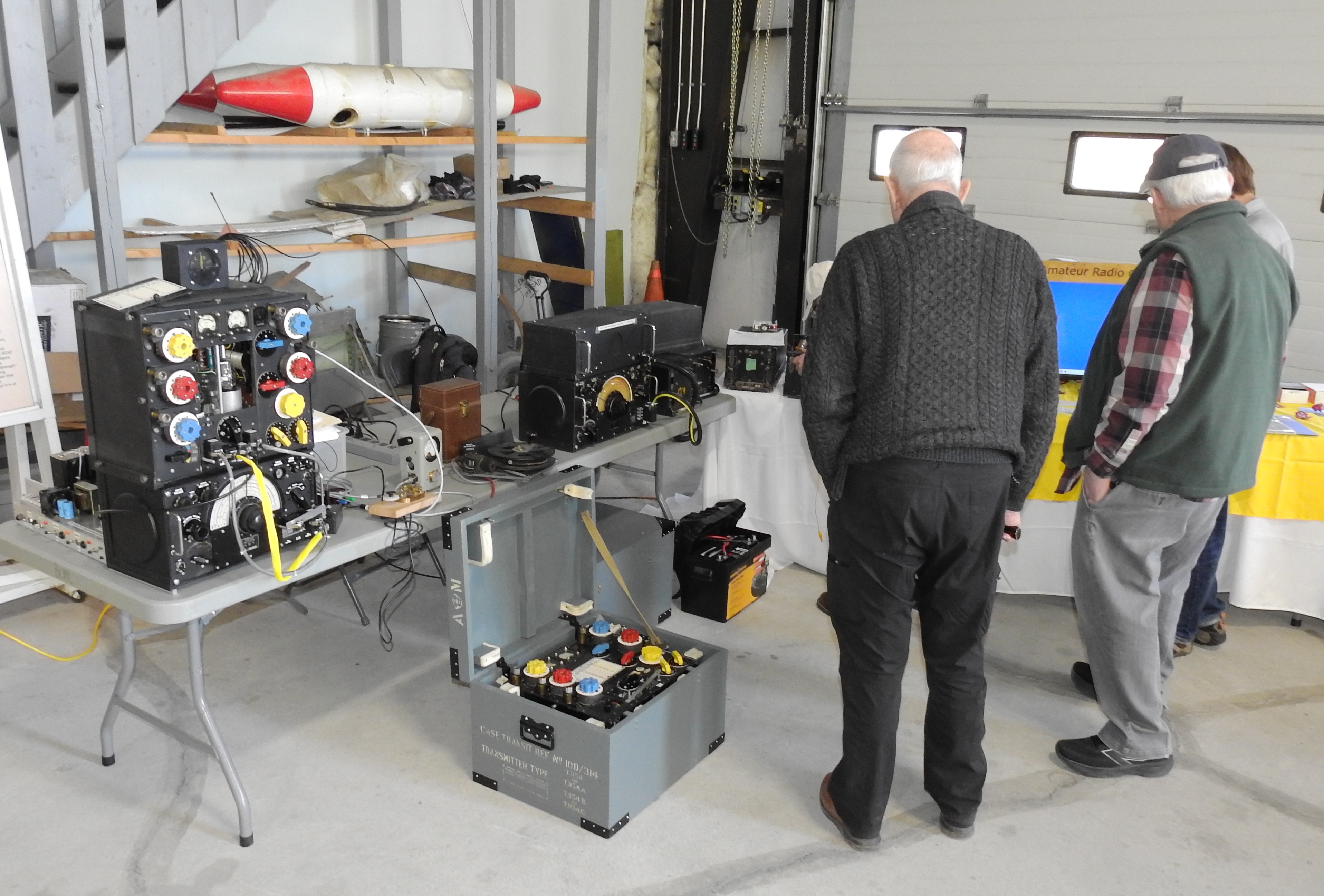
The first event day of the year celebrated the role of Bomber Command in dropping food to starving Dutch civilians in the last days of the war in Europe. At left, some of the WWII vintage radios brought out by ham radio operators for the day. The T1154 and R1155 sets were donated to the museum at the end of the event.

The flag of the Netherlands flies during the Lancaster engine run during the event to honour Operation Manna. In attendance as well was former Olympic Speed Skater Catriona Le May Doan who now serves as Honorary Consul of the Kingdom of the Netherlands in Calgary.
This was followed up on May 10th with "VE 'Engine-Run' Day, Commemorating the 80th Anniversary of Victory in Europe". The gods of weather cooperated to make for a great day of sun, engine noises and visitors.
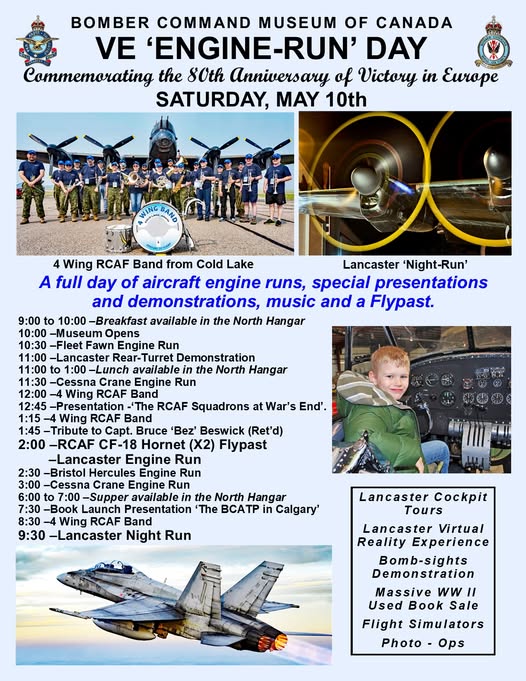
Event days at the museum are always an opportunity for us to talk to visitors about the important role played by the Mosquito during WWII and after.
The museum held its first ever event to celebrate and acknowledge National Indigenous Day, highlighting the +150 Indigenous airmen who joined Bomber Command during the Second World War.
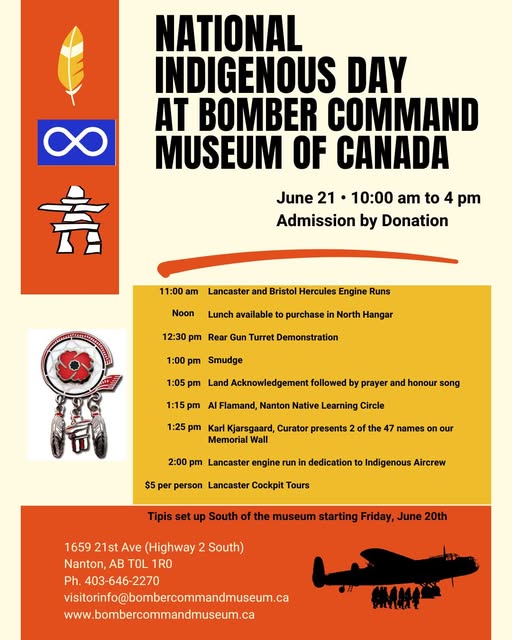
Smudging, songs, Indigenous dances and a presentation by museum curator, Karl Kjarsgaard highlighted the museum’s first ever National Indigenous Day event on June 21.
The day saw a smudging ceremony, singing, teepees erected inside the museum, dancers and a presentation highlighting some heroic Indigenous airmen by museum curator Karl Kjarsgaard. Sadly the gods of sun and clear skies were absent that weekend so there were no outdoor engine runs.
As always, we devote a lot of time on event days to speaking with visitors and doing our part to 'Honour and Educate' those who designed, built, flew, maintained and fought in the Mosquito.
As is done each year, the Mosquito gets it very own day of celebration at the Bomber Command Museum with tours, restoration updates, a presentation, Lancaster and Bristol Hercules engine runs and much more. This year's event is scheduled for Saturday, July 19 from 10 am to 5 pm. Come join if you can.
Over and out.

Richard de Boer, President
July 8, 2025
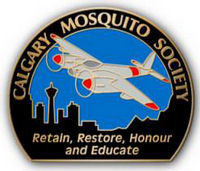
Website - Calgary Mosquito Aircraft Society


